
- Home
- >
- News
- >
- Life丨Village people
- >
Life丨Village people
2023-12-04 09:00
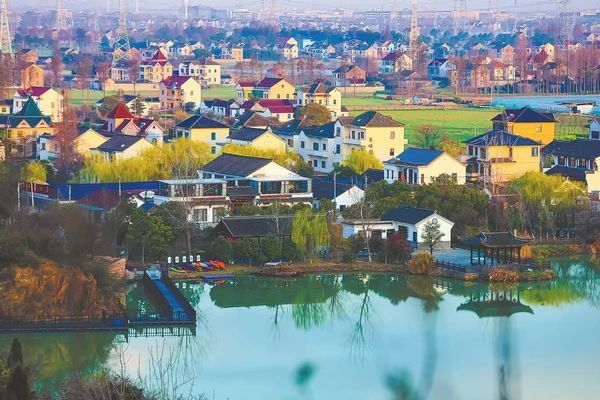
"All those facilities were built in old granaries that had been left unattended for a decade," says Xu Yiying, an officer with the village in Yaozhuang town, Jiaxing city of East China's Zhejiang province.
In 2021, local authorities hired professional designers to renovate the obsolete food warehouses, which were first built in around the 1960s, and give them modern functions.
"Most of them are in good shape, since the main structures still exist," Xu says. "We have preserved the original appearance and some essential aspects."
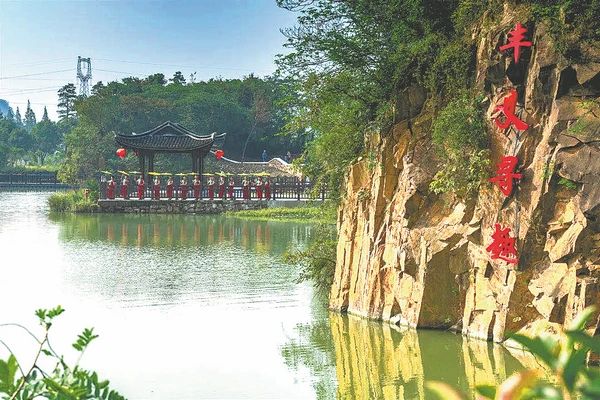
▲Tea tasting in ornate pavilions is a popular activity, as is observing various types of birds
The beams are still solid and were taken down carefully to restore before being reinstated, while the gray roof tiles are all original.
"They help the building to give off vintage charm in a modern setting," Xu says.
However, due to the passage of time and a lack of maintenance, the wooden framework had deteriorated, undermining the structural integrity of the warehouses. They have now been replaced with steel, Xu says.
Covering an area of more than 18,000 square meters, the granary site has evolved into a model of common prosperity.
Residents from neighboring villages have become frequent visitors to the site since it opened to the public in November last year.
"They have enjoyed coming here to read books and paint," Xu says.
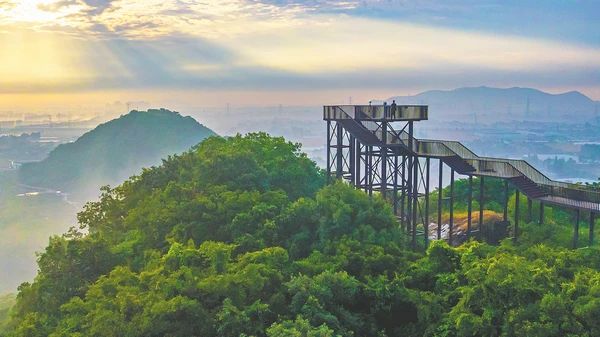
When night falls, many villagers will get together to sing and dance at the site.
Chen Genchuan, a local villager in his 60s, often spends two to three hours at the gallery painting. "I live in the neighborhood and often come here to kill time," Chen says.
He has created several works that feature the past image of the granaries. "They are all based on my memory, and each one takes about half a month to finish," Chen says, adding that many of his neighbors come to create farmers' paintings whenever they have time.
The granary site has also become popular among young village officials who convene regularly to discuss their work and brainstorm rural vitalization solutions.
"We visit different villages in Yaozhuang town and keep abreast of village development, and will come here about twice a week to discuss the next stage of our work," says Wang Qiqi, a young officer from Yaozhuang.
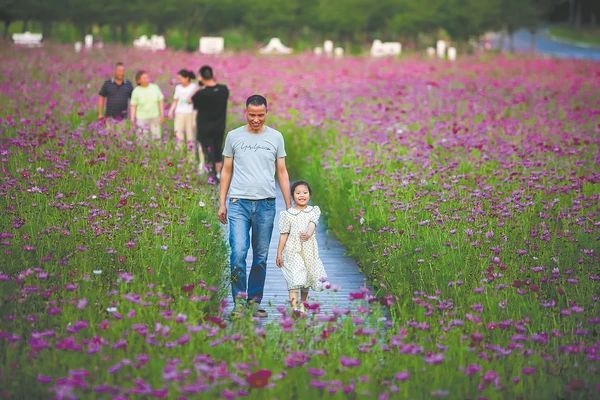
▲Visitors enjoy a sea of blossoms in Fengyi village, Zhejiang.
"The place is really nice and convenient for all of us to get to," he says.
About five minutes away by car, Jiangxiaoju orange park has been a rural getaway for visitors, many of whom travel from other parts of Zhejiang, nearby Shanghai and Jiangsu province to pick oranges and go camping.
"Travelers peak on weekends and holidays, when we usually receive about 400 to 500 guests a day," says Li Guangchuan, a manager in charge of the park's operations.
The park started receiving guests in June last year and has offered employment opportunities to many senior villagers, who help offer tourism services.
"They are mostly aged above 60 and earn a monthly salary of 4,000 yuan ($560)," Li says. "We also built an online platform to connect orange farmers with customers, which has significantly expanded sales channels."
Chenxiang village is home to nearly 67 hectares of orange groves. Local authorities have improved the environment and infrastructure and created rural homestays from houses that were standing idle, during the construction of the park.
The move has not only raised the living conditions for villagers, but also increased the sales of their oranges, as well as the number of visitors, says Wu Jiabin, a village official. "Now, the annual income of villagers has reached around 60,000 yuan, a win-win situation in terms of economic and ecological benefits."
Approximately two hours to the south by car, modern cafes and homestays are tucked away in a landscape of mountains and lakes in Fengyi village of Haiyan county in Jiaxing.
Many tourists can be seen strolling through the woods, chatting over coffee and camping on the grasslands in early November.
"Sometimes, it is still a little hard to imagine that over a decade ago, this place was once a dusty, barren sand and gravel quarry," says Jiang Guiying, owner of a grocery store in Fengyi village.
"At that time, the air was filled with dust, and after a day of work, our nostrils were filled with it," she recalls, adding that her family only earned between 1,000 yuan and 2,000 yuan a year.
About a decade ago, quarrying was the lifeblood of Fengyi. However, due to large-scale overexploitation, the mountain's ecosystem was damaged, and with the loss of vegetation came dust storms on sunny days and muddy water on rainy ones.
In 2016, the mines were closed and efforts were made to turn them into fields of blossoming flowers and tea gardens, says Zhu Mengdi, a publicity officer for the village.
Starting in 2017, the village began integrating natural, historical and cultural resources to create distinctive visitor experiences, featuring mountain hikes, lake visits, egret spotting, tea picking and tasting, and seasonal cherry blossom-related activities.
In 2022, the village was named by the Jiaxing government as its top-rated tourism village.
In the first six months of this year, Fengyi received more than 286,000 visitors, generating a tourism income of over 11.6 million yuan.
Zhao Shengbo, who opened an art studio that renovates and paints zaotou (kitchen stoves) in 2021, has benefited from the tourism boom.
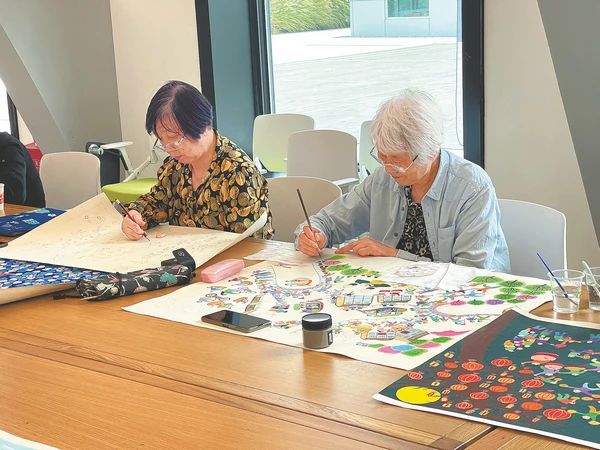
▲Visitors enjoy a sea of blossoms in Fengyi village, Zhejiang. Above: Residents practice painting at a granary-turned art gallery in Chenxiang village, Yaozhuang town, Zhejiang.
For four decades, Zhao has been practicing the distinctive art form of zaotou painting, which is listed as a national intangible cultural heritage. It was once common for farmhouses, especially those along the lower reaches of the Yangtze River, to have a zaotou that was painted with auspicious figures or floral motifs. Locals burned firewood and straw in it to cook, before gas burners and microwave ovens were available.
At Zhao's studio, visitors can try their hand at the art form by working on miniature zaotou.
"It is an efficient way for them to try, or to practice, the art form," Zhao says.
More than 1,000 visitors have visited his shop in Fengyi in the first 10 months of this year, he says.
"It has enabled more people from outside to learn about our regional art," he says.
Zhao has been invited to a dozen local schools to give regular lectures and teach students the history, culture and skills of zaotou painting.
Moreover, a greater number of clients from other provinces, such as Hebei and Anhui, have sought his services.
"My income has at least doubled this year," he says.
Lin Linlin from Shanghai was immediately drawn to the picturesque scenery and bustling tourism several years ago and decided to open a homestay in Fengyi in 2020.
She took over an abandoned clothing factory, which overlooked a lake, that had been unused for over four years.
Through unique design and arrangement, the dilapidated old building was transformed into a distinctive bed-and-breakfast, offering the charm of the Jiangnan region (the southern region along the lower reaches of the Yangtze River).
"Local officials gave me great support during the process," Lin says.
Now, her bed-and-breakfast offers more than 80 rooms, gourmet dining and conference facilities, as well as leisure activities.
"Travelers have been on the rise since the arrival of summer, and most of them stay for two or three nights," Lin says.
To meet the increasingly diverse needs of travelers, Lin has upgraded her homestay this year.
"We now offer karaoke, a barbecue, a parent-child amusement park and an outdoor swimming pool," Lin says.
"Whether it's team building, parties or gatherings, we can tailor our service to the needs of customers," she adds.
Yang Xilong, a traveler from Shanghai, has frequented Fengyi and neighboring villages in Zhejiang.
"They have not only an ideal environment but also a rich selection of businesses that can satisfy my travel needs," Yang says.








